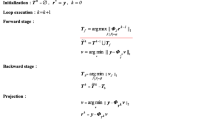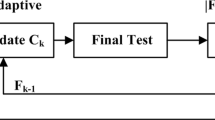Abstract
The traditional greedy algorithm requires the signal sparsity as a known condition, and in most application scenarios, the signal sparsity is unknown, resulting in poor signal reconstruction accuracy. In order to solve such problems, this paper proposes an adaptive dual threshold matching pursuit algorithm based on a variable-step backtracking strategy (SBATMP). Firstly, the suboptimal set of atoms is selected through two adaptive thresholds. Then, through the variable-step backtracking strategy, the atoms are selected twice to obtain the optimal atomic set. The algorithm can improve the complete reconstruction rate of the signal under the condition of unknown sparsity, and the variable-step backtracking strategy can effectively reduce the complexity of the algorithm. Through the reconstruction simulation experiment, the one-dimensional signal reconstruction accuracy can reach 100\(\%\) under the condition that the ratio of the sparsity to the measured value is less than 0.25. The reconstruction speed can be improved by 0.021\(-\)0.186 s. For the two-dimensional image signal, the PSNR of the reconstructed image by the SBATMP algorithm is increased by 1.193–5.781dB, and the SSIM is increased by 0.0116\(-\)0.0645 under the compression ratio of 0.7.







Similar content being viewed by others
Availability of data and materials
The datasets generated during and/or analyzed during the current study are available in the Baidu network disk repository, https://pan.baidu.com/s/1p3ZWZI7LBszWUdaCsTETHQ, extraction code: h9nu.
References
R. Baraniuk, Compressive sensing. IEEE Signal Process. Magaz. 24, 118 (2007)
T. Blumensath, M.E. Davies, On the difference between orthogonal matching pursuit and orthogonal least squares. Tech. Report. 24(2), 104–145 (2007)
W. Dai, O. Milenkovic, Subspace pursuit for compressive sensing: Closing the gap between performance and complexity (2008)
D.L. Donoho, Y. Tsaig, I. Drori, J.L. Starck, Sparse solution of underdetermined systems of linear equations by stagewise orthogonal matching pursuit. IEEE Trans. Informat. Theory 58(2), 1094–1121 (2012)
M. Elad, M.A. Figueiredo, Y. Ma, On the role of sparse and redundant representations in image processing. PROCEED- IEEE 98(6), 972–982 (2010)
Y.C. Eldar, G. Kutyniok, Compress. Sens. Theory Appl. (Compressed Sensing, Theory and Applications, 2012)
S. Foucart, H. Rauhut, Restricted isometry property (Springer, New York, 2013)
T. Han, K. Hao, X.-S. Tang, X. Cai, T. Wang, X. Liu, A compressed sensing network for acquiring human pressure information. IEEE Trans. Cognit. Developm. Syst. 14(2), 388–402 (2022)
A. Hashemi, H. Vikalo, Sampling requirements and accelerated schemes for sparse linear regression with orthogonal least-squares (2016)
A. Hashemi, H. Vikalo, Sparse linear regression via generalized orthogonal least-squares. IEEE 7, 1305–1309 (2016)
R. Hou, F. Li, Idpcnn: lterative denoising and projecting cnn for mri reconstruction. J Computat. Appl. Math. 406, 113973 (2022)
W. Jian, L. Ping, Recovery of sparse signals using multiple orthogonal least squares. IEEE Trans. Signal Process. 65(8), 2049–2062 (2017)
J. Kim, J. Wang, L.T. Nguyen, B. Shim, Joint sparse recovery using signal space matching pursuit. IEEE Transa. Inform Theory. 99(3), 1–10 (2020)
G. Li, X. Xiao, T. Jing-Tian, J. Li, Z. Hui-Jie, Z. Cong, Y. Fa-Bao, Near-source noise suppression of amt by compressive sensing and mathematical morphology filtering. Appl. Geophys. 14((004)), 581–589 (2017)
M. Li, S. Zhang, F. Gao, P. Fan, O.A. Dobre, A new path division multiple access for the massive mimo-otfs networks. IEEE J. Select. Areas Commun. PP(99), 1–1 (2020)
M. Mishali, Y.C. Eldar, From theory to practice: Sub-nyquist sampling of sparse wideband analog signals. IEEE J. Select. Topic Signal Process. 4(2), 375–391 (2010)
D. Needell, J.A. Tropp, Cosamp: iterative signal recovery from incomplete and inaccurate samples - sciencedirect. Appl. Computat. Harm. Analy. 26(3), 301–321 (2009)
D. Needell, R. Vershynin, Signal recovery from incomplete and inaccurate measurements via regularized orthogonal matching pursuit. IEEE J. Select. Topics. Signal Process. 4(2), 310–316 (2010)
F. Parvaresh, H. Vikalo, S. Misra, B. Hassibi, Recovering sparse signals using sparse measurement matrices in compressed dna microarrays. IEEE J. Select. Topics Signal Process. 2(3), 275–285 (2008)
M.K. Ramachandran, A. Chockalingam, Mimo-otfs in high-doppler fading channels: Signal detection and channel estimation. GLOBECOM 2018 - 2018 IEEE Global Communications Conference (2018)
P. Raviteja, K.T. Phan, Y. Hong, Embedded pilot-aided channel estimation for otfs in delay-doppler channels. IEEE Trans. Vehicul. Technol. PP(99), 1–1 (2019)
S.K. Sahoo, A. Makur, Signal recovery from random measurements via extended orthogonal matching pursuit. IEEE Trans. Signal Process. 63(10), 2572–2581 (2015)
W. Shen, L. Dai, J. An, P. Fan, Channel estimation for orthogonal time frequency space (otfs) massive mimo. IEEE Trans. Signal Process. PP(16), 1–1 (2019)
Z. Yin, Z. Wu, J. Zhang, A deep network based on wavelet transform for image compressed sensing. Circuits Syst. Signal Process. 64, 1–20 (2022)
H. Zhao, J. Zhang, L. Zhang, Y. Liu, T. Zhang, Compressed sensing image restoration based on non-local low rank and weighted total variation. J. Electron. Informat. Technol. 41(8), 2025–2032 (2019)
Y. Zhu, S. WuZhen, W. Zhongcheng, Z. Jun, Multilevel wavelet-based hierarchical networks for image compressed sensing. Pattern Recognit. 129, 108758 (2022)
Acknowledgements
Acknowledgments are not compulsory. Where included they should be brief. Grant or contribution numbers may be acknowledged.
Author information
Authors and Affiliations
Corresponding author
Ethics declarations
Conflicts of interest
The authors declare that they have no known competing financial interests or personal relationships that could have appeared to influence the work reported in this paper.
Additional information
Publisher's Note
Springer Nature remains neutral with regard to jurisdictional claims in published maps and institutional affiliations.
Rights and permissions
Springer Nature or its licensor (e.g. a society or other partner) holds exclusive rights to this article under a publishing agreement with the author(s) or other rightsholder(s); author self-archiving of the accepted manuscript version of this article is solely governed by the terms of such publishing agreement and applicable law.
About this article
Cite this article
Xiang, J., Li, H., Qi, L. et al. Sparse Signal and Image Reconstruction Algorithm for Adaptive Dual Thresholds Matching Pursuit Based on Variable-step Backtracking Strategy. Circuits Syst Signal Process 42, 2132–2148 (2023). https://doi.org/10.1007/s00034-022-02177-2
Received:
Revised:
Accepted:
Published:
Issue Date:
DOI: https://doi.org/10.1007/s00034-022-02177-2




